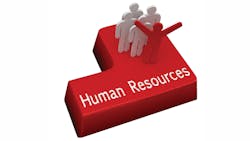If you think that “same old, same old” still works when dealing with your employees, think again. Today’s workforce is not the same as the workforce you dealt with 15, 10 or even five years ago. The change is not just based on the fact that your workforce may be made up of younger employees — that’s just part of it. The bottom line is that workers of all ages are thinking differently about what they want out of their job. As a result, as their supervisor or manager you have to recognize these changes if you want to keep (and keep motivated) your best employees.
Some food for thought:
- 52% of today’s workforce is not engaged;
- 48% are not satisfied with their boss; and
- 18% are so dis-engaged that they work against the organization’s goals.
Steps to Improving Engagement
What can managers do to improve employee engagement, deal more effectively with employees, increase productivity and improve performance? Some simple, cost effective steps include:
1. Listen to your employees’ opinions: Today’s employees want to actively participate and to contribute to the success of their organization. Your role as their manager/supervisor is to open the door to effective, two-way discussions. Don’t be surprised if they provide solid, valuable input — you do not have all the best answers!
2. Communicate clear expectations: If your employees do not have a full understanding of what you want them to do, that’s your problem, not theirs. Few employees go to work wanting to do a bad job, most want to “do good” — but in the absence of clear expectations, they will do what they assume you want them to do and that may not produce the your desired outcome.
3. Give praise and recognition: How cost effective is this!? A simple “thank you” or “job well done” can go a long way toward satisfying the needs of employees who want to be appreciated. And offering recognition positively reinforces the level of performance and quality of work that you want them to consistently achieve.
4. Provide learning and development opportunities: Workers of all ages want to feel fulfilled. It is not like it was back in the days when mass production on the factory floor had workers turning lug-nuts. Current work environments are more complex and workers want to be allowedand encouraged to learn new things and to have opportunities to grow their skill sets.
The bottom line is, if you are not using these four items, you may fall into the “poor manager” bucket. Don’t make the mistake of assuming that workers need your company more than the company needs them. Good workers know that they can leave — they have mobility and self-confidence — and as the economy picks up and jobs are more readily available, they may.
Effective Communication Strategies
Good communication builds a sense of community among employees by letting them in on the business of the business; and more importantly, it addresses issues of poor or non-performance.
It is important for employees to understand why the business was established. The Mission Statement can answer questions like What do we do? How do we do it? and For whom do we do it? The Mission Statement serves as a reminder of the purpose of the business, and gives employees a sense of where they fit and how their job moves the company forward toward those objectives.
Employees are not mind readers. They need clear, precise directions, instructions, and expectations from supervisors and management. Several printed communication channels are useful here in addition to how supervisors and managers verbally communicate with employees.
Handbooks are the primary channel for describing expectations. A well-written handbook tells employees how to behave in the workplace and sets forth consequences for failure to meet those expectations. Handbooks also inform employees of what they can expect from the company in exchange for their work — benefits, holidays, vacation, overtime, etc. Communicate clearly to reduce liabilities through misunderstandings of mutual expectations.
While not as obvious a tool as the handbook, Performance Reviews communicate how well or how poorly each employee is performing and meeting company expectations. A timely, well-written review says, “We value you and your contributions and here are some areas we can work on together to improve your performance and the company’s success.”
Postings, those required by state and federal laws, and company-specific postings addressing successes, celebrations, new products, expansion efforts and other notices of the company’s level of performance go a long way toward reducing anxieties many employees face in a volatile economy.
Finally, Job Descriptions communicate the expectations in terms of tasks and responsibilities for each position. Employees are not forced to guess what they are to do to meet individual and company objectives. By doing the right tasks, the goals of the individual, department and division can be met.
Aside from one-on-one personal communication, company-wide communication is necessary to keep the workforce engaged and informed, thereby increasing productivity and improving performance.
Ted Szaniawski is founder and Principal of HRGroup, a provider of Human Resource support services, including hiring practices, compensation programs, talent development and more. For additional info, or to suggest a topic for a future article, email:[email protected].
Margaret Jacoby, SPHR is President & Principal Consultant of MJ Management Solutions Inc., a strategic partner of HRGroup, serving emerging businesses in the areas of HR compliance and support.
About the Author
Margaret Jacoby
Margaret Jacoby, SPHR, is President & Principal Consultant of MJ Management Solutions Inc., a strategic partner of HRGroup, a provider of Human Resource support services, including hiring practices, compensation programs, talent development and more. MJ Management Solutions offers a book, “Practical Tools to Manage Costly Employee Turnover” and a “tips and Tools” newsletter. Learn more at www.mjms.net.
